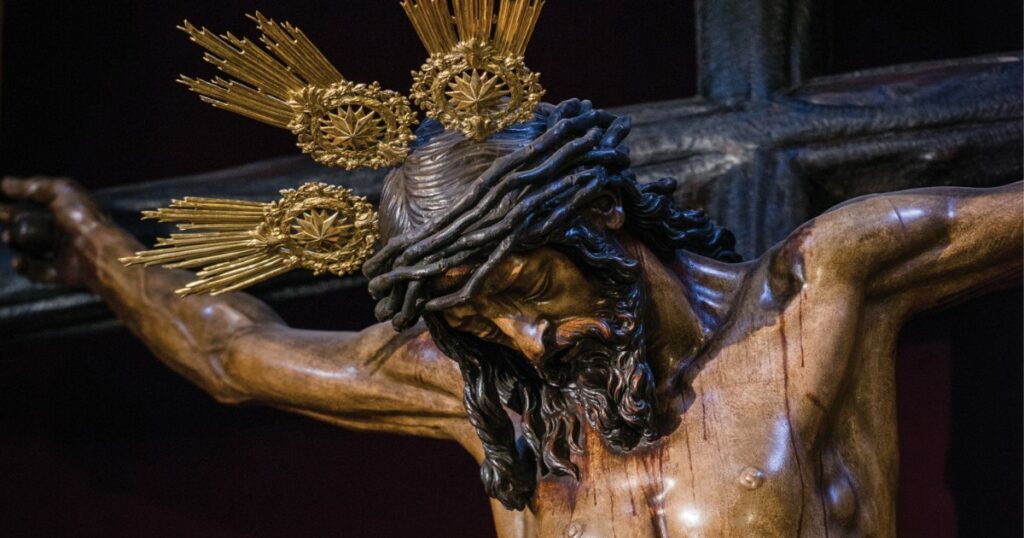by Jocelyn Benson
Hands grasp palm branches and voices soar with hosannas. Holy Week is here. A mere 40 days ago, on Ash Wednesday, children looked with wide eyes as their pastor smeared ash on foreheads and declared, “Remember, oh man, thou art but dust and to dust thou shalt return.”
Now, as Holy Week begins, their hands grasp the very palms that will next year comprise the ash that reminds them they are dust. How fitting that our palm waving and cries of “Save us, now!” (“Hosanna!”) connect us back to our remembrance that we are dust! As our hosannas fade, we hear the Passion according to St. Matthew. How quickly the tone of our journey has changed!
Holy Week continues on Monday. While nothing changes with the paraments, the lectionary leads us forward. Monday of Holy Week we read of our Lord’s anointing in the Gospel according to St. John. Tuesday of Holy Week we read the Passion according to St. Mark. Wednesday of Holy Week we read the Passion according to St. Luke. The Lutheran Study Bible provides a great illustration on pp. 1690-1691 that can aid in the reading and hearing of these accounts. In family or congregational settings, the readings can be made even more powerful by putting the words of the crowds into the mouths of the people. How jarring it is to speak the “hosannas” with the Palm Sunday crowds and shortly thereafter shout “crucify Him” with the Good Friday throng.
The words of Scripture lead us through Holy Week. Yet these words are not heard only in our readings. The Holy Week section of our hymnal gives us richness second only to Scripture. Saints have sung “O Sacred Head, Now Wounded,” “Upon the Cross Extended,” “Sing, My Tongue, the Glorious Battle” and “The Royal Banners Forward Go” since as early as the sixth century. What a glorious heritage of hymnody we have to escort us on our Holy Week journey!
Maundy Thursday brings us back to the Gospel according to St. John. We hear the account of Jesus washing His disciples’ feet. Many of our congregations grace the altar with white paraments and bring back the greater Gloria in celebration of the institution of the Lord’s Supper. After celebrating the Lord’s Supper, we sit and watch as the altar is stripped. In some congregations, the cantor or choir chants Psalm 22 during the stripping of the altar. We hear at the beginning of this psalm, “My God, my God, why have you forsaken me?” and as the psalm continues, we feel a literal forsakenness as the altar and chancel become bare before our eyes. The silence at the end of the service is almost deafening.
The silence of Maundy Thursday continues on Good Friday. We may see black paraments on the altar on this day.
In the Chief Service, the Passion according to St. John carries us forward in our Holy Week journey, often broken up and interspersed with verses from the beautiful hymn, “O Sacred Head, Now Wounded.” In the Reproaches, we hear the words of our Lord against His people and we, His people, respond with a cry for mercy. “Lamb of God, Pure and Holy,” breaks through our cries for mercy, its repetition providing young and old alike a melody that gives shape to our pleas for mercy.
The Tenebrae service on Good Friday also begins in silence. Tenebrae is a Latin word meaning “darkness.” As the service progresses, so also does the darkness. Throughout the service, the lights are dimmed, seven candles may be extinguished one by one and congregants may leave in almost complete darkness. Sometimes, as the last candle is extinguished and darkness floods the nave, a loud noise, called the strepitus, is heard. Even when it is expected, it is a jarring noise, followed again by silence.
The darkness and silence overwhelm the senses. A longing for light and alleluias draws God’s people, in eager anticipation, to the Vigil of Easter. The congregants may gather around a fire outside the church. Armed with candles, they are keeping watch, waiting for the Resurrection of Our Lord. Even though we know how the story ends, the sacred Triduum (Maundy Thursday, Good Friday, Holy Saturday) keeps the longing fresh and real each and every year. Taking away the Gloria, the alleluias, and even the light, stirs in us a yearning that is almost unbearable. Yet the Vigil of Easter, this most ancient of services, girds us for the last hours of our Holy Week Journey. The candles, the readings, the baptismal remembrance and the prayers lead us ever onward until we can finally say those most longed-for words, “Alleluia! Christ is Risen! He is risen indeed! Alleluia!”
Jocelyn Benson is a member of Saint Paul Evangelical Lutheran Church in Chatfield, Minn. She serves as head teacher of Wittenberg Academy.





